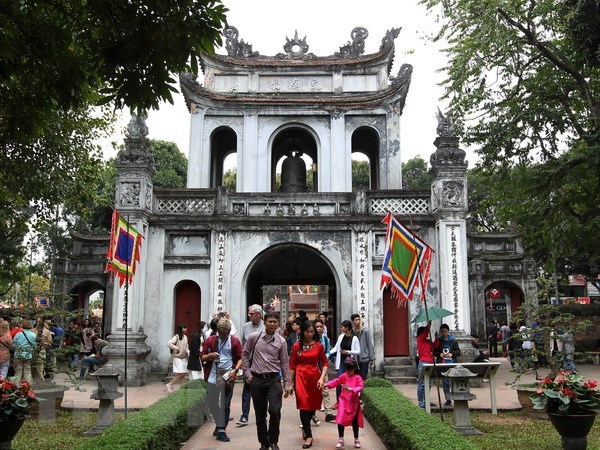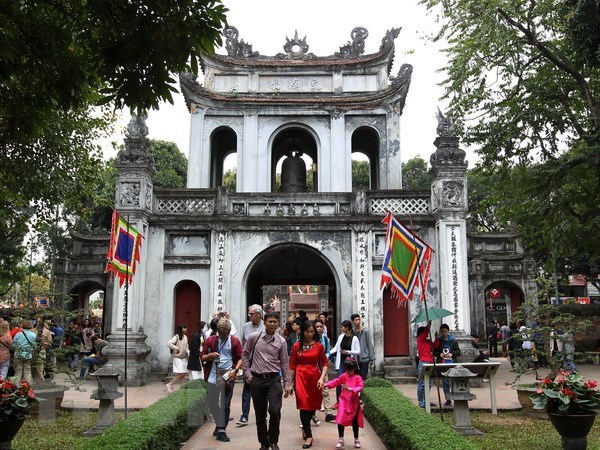
Representatives from 65 Japanese and Hanoi firms joined a programme to promote tourism in the capital Vietnamese city on August 24.

Van Mieu - Quoc Tu Giam in Hanoi (Source: VNA)
Japanese guests enjoyed folk music performances, watched a clip
introducing Hanoi’s tourism which was produced by the US’ CNN television
channel, and met with local businesses and the media to learn about the city’s
tourism products and destinations.
They gained an insight into Hanoi’s tangible and intangible heritages,
ecological tourism and entertainment areas, shopping centres, travel agencies,
lodging facilities, transportation, and tourism linkage with other
localities.
Tran Duc Hai, Director of the municipal Department of Tourism, said foreign
arrivals to Hanoi grew by 18 percent annually during the 2015-2017 period,
hitting 4.95 million people last year, up 23 percent year-on-year. In the first
seven months of the year, the figure rose by 21 percent year-on-year to reach
3.4 million.
Japan remained among the top three sources of tourists to Hanoi with 290,170
arrivals last year, up 22 percent annually. The seven-month figure was 166,437,
marking an 8 percent year-on-year increase.
Hai committed all possible support for Japanese travel agencies, press outlets,
and tourists in the near future and expressed his hope that Japanese firms will
offer more tours to Vietnam and Hanoi in particular.
Ara Saeko from JTB tourism company expressed wishes that Vietnam’s tourism
sector would upgrade local infrastructure, relax visa procedures, adjust tour
prices and better popularise destinations to attract more Japanese
visitors.
Japanese guests also visited Thang Long imperial citadel, Van Mieu-Quoc Tu
Giam, Hanoi’s Old Quarter, Duong Lam ancient village, Van Phuc silk village,
and Ha Long Bay in the northern province of Quang Ninh. –VNA
Source: NDO
A diverse chain of eco-tourism and resort destinations concentrated in Hoa Binh city and the districts of Tan Lac, Da Bac, and Luong Son… Along with the launch of several key high-quality resort tourism projects, these developments have reshaped the landscape and enhanced the appeal of Hoa Binh as a travel destination.
Boasting diverse terrain, a mild climate, and rich natural resources, Cao Phong district is increasingly asserting its place on Vietnam’s tourism map, attracting both domestic and foreign visitors. The district is renowned for its stunning landscapes, majestic mountains, a crystal-clear hydropower lake, and the unique cultural identity of local ethnic groups.
With its pristine landscapes, unique cultural heritage of Muong ethnic minority, and an expanding range of visitor experiences, Tan Lac district of Hoa Binh has fast become a captivating destination for both domestic and international tourists.
Until now, Sung village in Cao Son commune, Da Bac district remains the only Dao ethnic community in Hoa Binh province to develop a community-based tourism model. Beyond its untouched natural landscapes, cultural identity serves as the cornerstone attraction for visitors.
Alongside the diverse cultural identities of the Kinh, Muong, Tay, Thai, Dao, and Mong ethnic people, Hoa Binh province is also renowned as the "capital" of the northwestern Vietnamese cuisine, offering unique and distinctive dishes. At festivals, during Lunar New Year (Tet), or on significant family or community occasions, special dishes are prepared, leaving a lasting impression on visitors.
A Phong Linh (Yellow Tabebuia) flower garden in Thang village, Thach Yen commune, Cao Phong district is currently in full bloom, drawing a large number of visitors.



